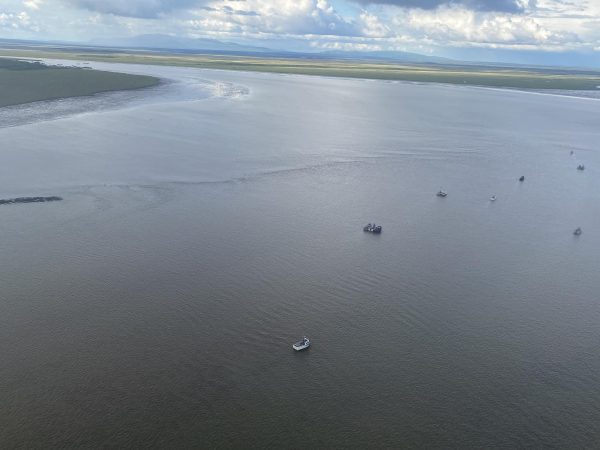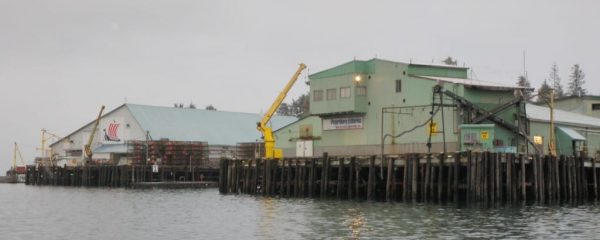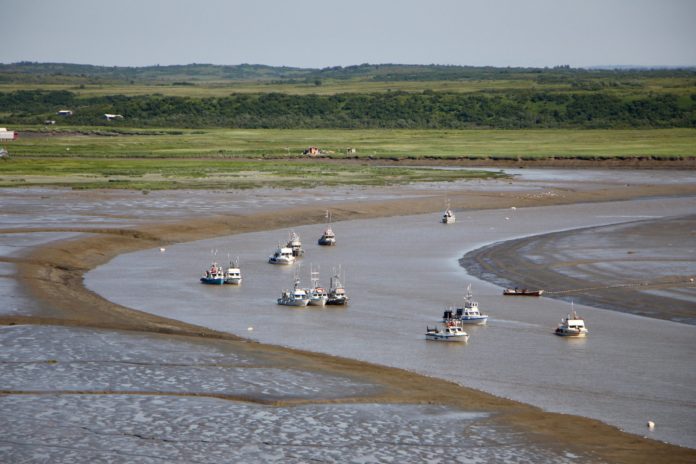As this year’s summer fishing season approached, local leaders across Alaska issued dire warnings about the thousands of plant workers and fishermen headed to their communities.
They feared the workers could bring COVID-19 in with them, quickly overwhelming small local hospitals and clinics. In Bristol Bay, home to the world’s largest sockeye salmon fishery, some residents called on Gov. Mike Dunleavy to cancel the season, citing the region’s traumatic experience with the 1918 pandemic flu, which killed at least 30% of its population.
In the month since the Bristol Bay season kicked off, some seafood companies have experienced isolated cases among workers in their processing plants. And other outbreaks have infected dozens of seafood workers elsewhere in the state — most recently, 85 crew members on board a Bering Sea factory trawler.
Read comprehensive coverage of COVID-19 from Alaska Public Media
But midway through summer, with the Bristol Bay season winding down, seafood company executives and public health authorities can point to a remarkable fact: The industry has been almost completely successful in keeping its seasonal workers and fishermen from infecting Alaska residents.
“We haven’t seen any evidence of jumping the fence from the seafood industry to the community,” Bryan Fisher, a top state emergency response official, said in an interview earlier this month.
In the Bristol Bay Borough, home to the region’s largest concentration of fish processing plants, there have been dozens of cases of COVID-19 among nonresident seafood workers — but just one case among residents.

Gene Sanderson lives in the borough year-round, and his house is on the grounds of a processing plant, where he works as a watchman during the winter.
When thousands of fishermen and processing workers started arriving to the area for this summer’s salmon season, Sanderson and his wife left for their cabin.
Sanderson, in a phone interview, said he was initally skeptical that the fishing industry would be able to keep the virus confined to boats and processing plants. But after a month of calm, he and his wife returned to their home early.
“It’s gone amazingly — knock on wood,” he said. “Fishermen are starting to come out of the water, and they’re starting to head out of town.”
Now that it’s almost over, Sanderson says he’s happy the Bristol Bay season went forward, bringing its yearly boost of jobs and tax revenue to the region.
Across Alaska’s fishing towns, local leaders have similar messages to share, as officials report that almost all cases of the virus among seasonal workers have been successfully contained. The only exception is at a processing plant in Juneau which, unlike many of the other plants across the state, employs some resident workers.
Fishing industry players say this did not happen by accident. The state of Alaska, under pressure from the leaders of concerned fishing communities, imposed strict quarantine mandates, and required companies to draft rigorous COVID-19 containment plans.
Alaska’s fishing communities have plans to contain COVID-19. Now they’ll be put to the test.
Those companies enacted comprehensive testing regimes and barred processing workers and fishermen from leaving company property or even getting off their boats.
“It is, seriously, like prison,” said Dan Martin, the skipper of a vessel that fishes for pollock out of Dutch Harbor, the Aleutian Island fishing port.

Typically, crew members get to stretch their legs every few days after each fishing trip; they can go for hikes, rent movies or catch a ride into town for dinner at the Norwegian Rat saloon.
This year, in the six weeks Martin has spent on his vessel so far, he got off just twice — once to help another crew with some electronics, and a second time to fly home for a break.
Martin said he’s proud of his fellow fishermen for the lengths they’ve gone to protect residents of Dutch Harbor and neighboring Unalaska. But he also said the restrictions are driving them a little crazy, especially because the fishing this summer has not been good.
“It’s almost an untenable situation — slow fishing and all these things compounded, and you’re in each other’s face 24/7 and it goes on and on and on,” he said. “I can definitely see people getting onto the ragged edge by the end of the season.”
So far, though, officials have praised companies for staying vigilant even as the fishing season and pandemic drag on. In the Southeast Alaska town of Petersburg, Karl Hagerman, a local emergency response official, said he watched as the crab season kicked off, straining one processor’s capacity as it was waiting for more workers to finish quarantine.

While more workers would have been useful to the company, he said, “they’re sticking with their quarantine.”
“They’re protecting the workers that are on the line right now, as well as the workers that are going to be on the line as soon as they’re done with their quarantine. And they’re protecting the community,” Hagerman said. “I’ve got to hand it to them — they’re doing a great job.”
Outside of Bristol Bay, there are still months left in the salmon season, and there are winter fisheries for other species. Which means that no one — from public health authorities to the fishing companies themselves — is declaring victory yet.
“We fully recognize, as an industry and as a company, that we have a long way to go. We are not done adjusting our plans and learning from what we know of COVID,” said Julianne Curry, a spokesperson for Icicle Seafoods. “Every single day, we incorporate new things that we learn into our plans.”
Icicle, which processes pollock on a massive ship docked in Dutch Harbor, has already been absorbing lessons from the events of the summer, Curry added. She said the company’s early experience showed how important it is to swiftly isolate not just infected workers, but also their close contacts — those who hadn’t tested positive for the virus but who had spent time around someone who had.
Early on, two to four close contacts of an infected person might still have been quarantined in a room together, Curry said. Now each one is isolated in their own room.
Health-care experts, emergency response officials and seafood industry leaders all said open communication was a key factor in the apparent success of their containment efforts. Fisher, the state official, said that local pressure for tight mandates and enforcement was important, too.
“The community concern about bringing in out-of-state, out-of-country workers really helped us all focus on that,” he said. “They were valid concerns, we took them to heart, and industry certainly did, too.”
Credit: Source link






























